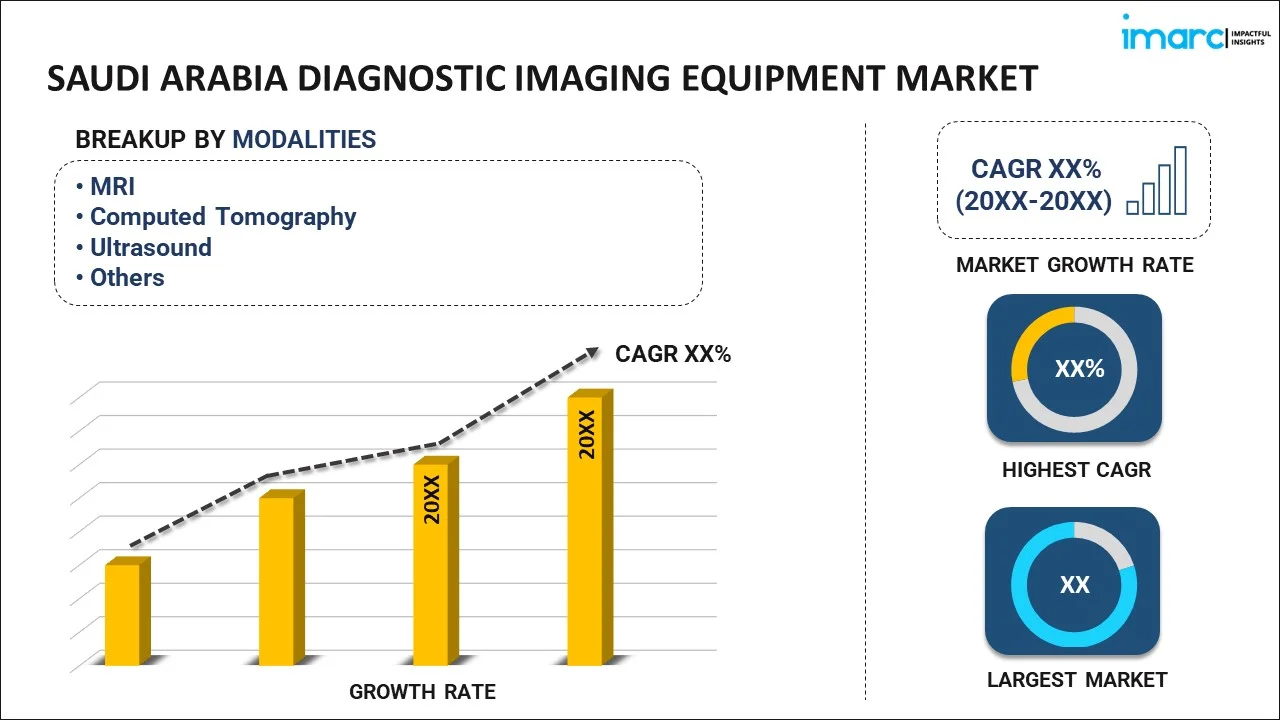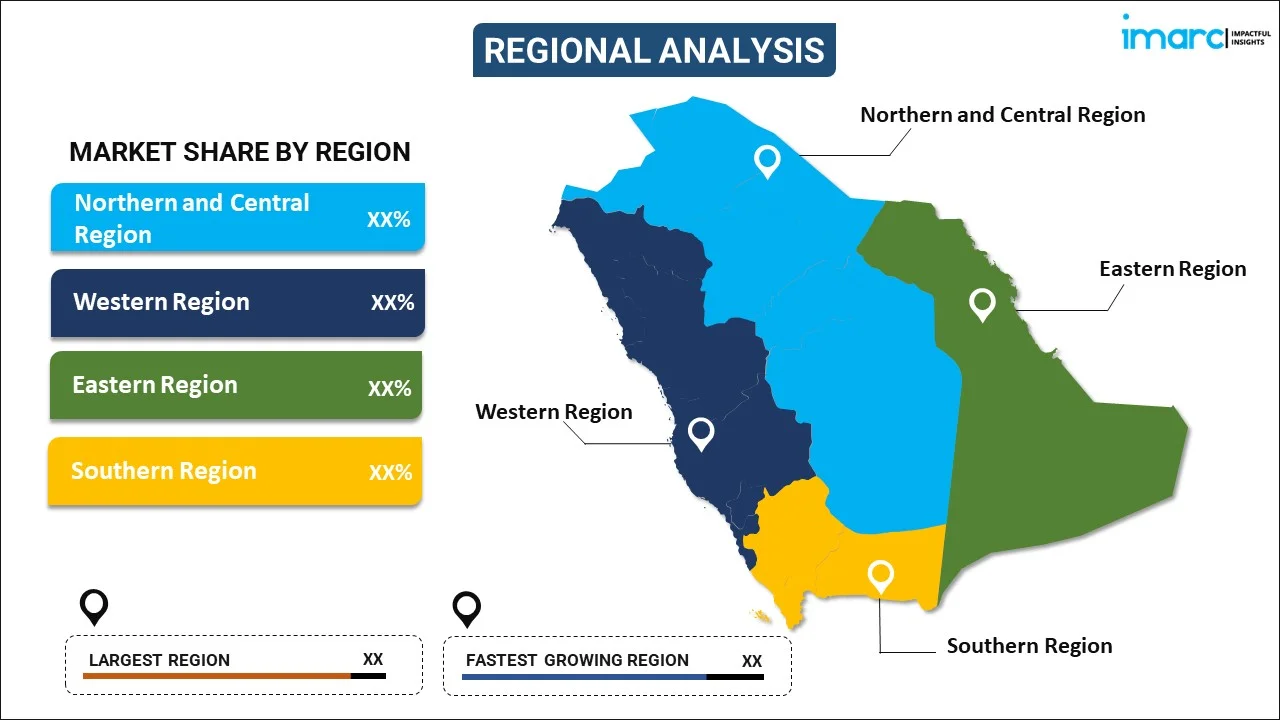
Saudi Arabia Diagnostic Imaging Equipment Market Report by Modality (MRI, Computed Tomography, Ultrasound, X-Ray, Nuclear Imaging, Fluoroscopy, Mammography), Application (Cardiology, Oncology, Neurology, Orthopedics, Gastroenterology, Gynecology, and Others), End User (Hospital, Diagnostic Centers, and Others), and Region 2025-2033
Market Overview:
Saudi Arabia diagnostic imaging equipment market size reached USD 377 Million in 2024. Looking forward, IMARC Group expects the market to reach USD 515 Million by 2033, exhibiting a growth rate (CAGR) of 3.54% during 2025-2033. The increasing need for high-quality healthcare services, along with the emerging trend of medical tourism, is primarily driving the market growth.
|
Report Attribute
|
Key Statistics
|
|---|---|
|
Base Year
|
2024 |
|
Forecast Years
|
2025-2033
|
|
Historical Years
|
2019-2024
|
| Market Size in 2024 | USD 377 Million |
| Market Forecast in 2033 | USD 515 Million |
| Market Growth Rate (2025-2033) | 3.54% |
Diagnostic imaging equipment refers to a category of advanced medical devices and technologies used for visualizing and diagnosing medical conditions within the human body. These devices play a crucial role in modern healthcare by providing detailed, non-invasive images of internal structures, organs, and tissues. Diagnostic imaging encompasses various modalities, including X-ray, computed tomography (CT), magnetic resonance imaging (MRI), ultrasound, and nuclear medicine techniques like positron emission tomography (PET) scans. Each modality uses different principles to capture images, enabling healthcare professionals to identify and evaluate a wide range of medical conditions, from bone fractures and tumors to heart diseases and neurological disorders. These imaging technologies aid in early disease detection, treatment planning, and monitoring patient progress, contributing to improved patient outcomes and a deeper understanding of the human body's intricacies.
Saudi Arabia Diagnostic Imaging Equipment Market Trends:
The Saudi Arabia diagnostic imaging equipment market is experiencing significant growth, driven by a combination of factors that underline the country's commitment to advancing healthcare infrastructure and ensuring access to cutting-edge medical technologies. One of the key drivers is the increasing prevalence of chronic diseases and the aging population, necessitating more sophisticated diagnostic tools. Consequently, there's a rising demand for advanced imaging modalities such as magnetic resonance imaging (MRI), computed tomography (CT), and positron emission tomography (PET) scans to enhance disease detection and treatment planning. A notable trend in the market is the shift towards digital radiography and picture archiving and communication systems (PACS). These technologies enable healthcare providers to store and transmit diagnostic images electronically, improving efficiency and accessibility of patient data. Additionally, the adoption of artificial intelligence (AI) and machine learning algorithms for image analysis is gaining traction, aiding in more accurate and timely diagnosis. The COVID-19 pandemic has further accelerated the market, as healthcare facilities seek to upgrade their imaging equipment to meet the increased demand for diagnostic services and improve infection control measures. These investments include the establishment of state-of-the-art medical facilities, which, in turn, drive the demand for diagnostic imaging equipment. All above mentioned factors are projected to fuel the regional market over the forecasted period.
Saudi Arabia Diagnostic Imaging Equipment Market Segmentation:
IMARC Group provides an analysis of the key trends in each segment of the market, along with forecasts at the country level for 2025-2033. Our report has categorized the market based on modality, application, and end user.
Modality Insights:

- MRI
- Computed Tomography
- Ultrasound
- X-Ray
- Nuclear Imaging
- Fluoroscopy
- Mammography
The report has provided a detailed breakup and analysis of the market based on the modality. This includes MRI, computed tomography, ultrasound, X-ray, nuclear imaging, fluoroscopy, and mammography.
Application Insights:
- Cardiology
- Oncology
- Neurology
- Orthopedics
- Gastroenterology
- Gynecology
- Others
A detailed breakup and analysis of the market based on the application have also been provided in the report. This includes cardiology, oncology, neurology, orthopedics, gastroenterology, gynecology, and others.
End User Insights:
- Hospital
- Diagnostic Centers
- Others
The report has provided a detailed breakup and analysis of the market based on the end user. This includes hospital, diagnostic centers, and others.
Regional Insights:

- Northern and Central Region
- Western Region
- Eastern Region
- Southern Region
The report has also provided a comprehensive analysis of all the major regional markets, which include Northern and Central Region, Western Region, Eastern Region, and Southern Region.
Competitive Landscape:
The market research report has also provided a comprehensive analysis of the competitive landscape in the market. Competitive analysis such as market structure, key player positioning, top winning strategies, competitive dashboard, and company evaluation quadrant has been covered in the report. Also, detailed profiles of all major companies have been provided. Some of the key players include:
- AGFA HealthCare N.V. (Agfa-Gevaert N.V.)
- Canon Medical Systems Corporation
- FONAR Corporation
- FUJIFILM Holdings Corporation
- GE HealthCare Technologies Inc.
- Koninklijke Philips N.V.
- Shimadzu Corporation
- Siemens Healthineers
(Please note that this is only a partial list of the key players, and the complete list is provided in the report.)
Saudi Arabia Diagnostic Imaging Equipment Market Report Coverage:
| Report Features | Details |
|---|---|
| Base Year of the Analysis | 2024 |
| Historical Period | 2019-2024 |
| Forecast Period | 2025-2033 |
| Units | Million USD |
| Scope of the Report | Exploration of Historical Trends and Market Outlook, Industry Catalysts and Challenges, Segment-Wise Historical and Future Market Assessment:
|
| Modalities Covered | MRI, Computed Tomography, Ultrasound, X-Ray, Nuclear Imaging, Fluoroscopy, Mammography |
| Applications Covered | Cardiology, Oncology, Neurology, Orthopedics, Gastroenterology, Gynecology, Others |
| End Users Covered | Hospital, Diagnostic Centers, Others |
| Regions Covered | Northern and Central Region, Western Region, Eastern Region, Southern Region |
| Companies Covered | AGFA HealthCare N.V. (Agfa-Gevaert N.V.), Canon Medical Systems Corporation, FONAR Corporation, FUJIFILM Holdings Corporation, GE HealthCare Technologies Inc., Koninklijke Philips N.V., Shimadzu Corporation, Siemens Healthineers, etc. |
| Customization Scope | 10% Free Customization |
| Post-Sale Analyst Support | 10-12 Weeks |
| Delivery Format | PDF and Excel through Email (We can also provide the editable version of the report in PPT/Word format on special request) |
Key Questions Answered in This Report:
- How has the Saudi Arabia diagnostic imaging equipment market performed so far and how will it perform in the coming years?
- What has been the impact of COVID-19 on the Saudi Arabia diagnostic imaging equipment market?
- What is the breakup of the Saudi Arabia diagnostic imaging equipment market on the basis of modality?
- What is the breakup of the Saudi Arabia diagnostic imaging equipment market on the basis of application?
- What is the breakup of the Saudi Arabia diagnostic imaging equipment market on the basis of end user?
- What are the various stages in the value chain of the Saudi Arabia diagnostic imaging equipment market?
- What are the key driving factors and challenges in the Saudi Arabia diagnostic imaging equipment?
- What is the structure of the Saudi Arabia diagnostic imaging equipment market and who are the key players?
- What is the degree of competition in the Saudi Arabia diagnostic imaging equipment market?
Key Benefits for Stakeholders:
- IMARC’s industry report offers a comprehensive quantitative analysis of various market segments, historical and current market trends, market forecasts, and dynamics of the Saudi Arabia diagnostic imaging equipment market from 2019-2033.
- The research report provides the latest information on the market drivers, challenges, and opportunities in the Saudi Arabia diagnostic imaging equipment market.
- Porter's five forces analysis assist stakeholders in assessing the impact of new entrants, competitive rivalry, supplier power, buyer power, and the threat of substitution. It helps stakeholders to analyze the level of competition within the Saudi Arabia diagnostic imaging equipment industry and its attractiveness.
- Competitive landscape allows stakeholders to understand their competitive environment and provides an insight into the current positions of key players in the market.
Need more help?
- Speak to our experienced analysts for insights on the current market scenarios.
- Include additional segments and countries to customize the report as per your requirement.
- Gain an unparalleled competitive advantage in your domain by understanding how to utilize the report and positively impacting your operations and revenue.
- For further assistance, please connect with our analysts.
 Request Customization
Request Customization
 Speak to an Analyst
Speak to an Analyst
 Request Brochure
Request Brochure
 Inquire Before Buying
Inquire Before Buying




.webp)




.webp)












